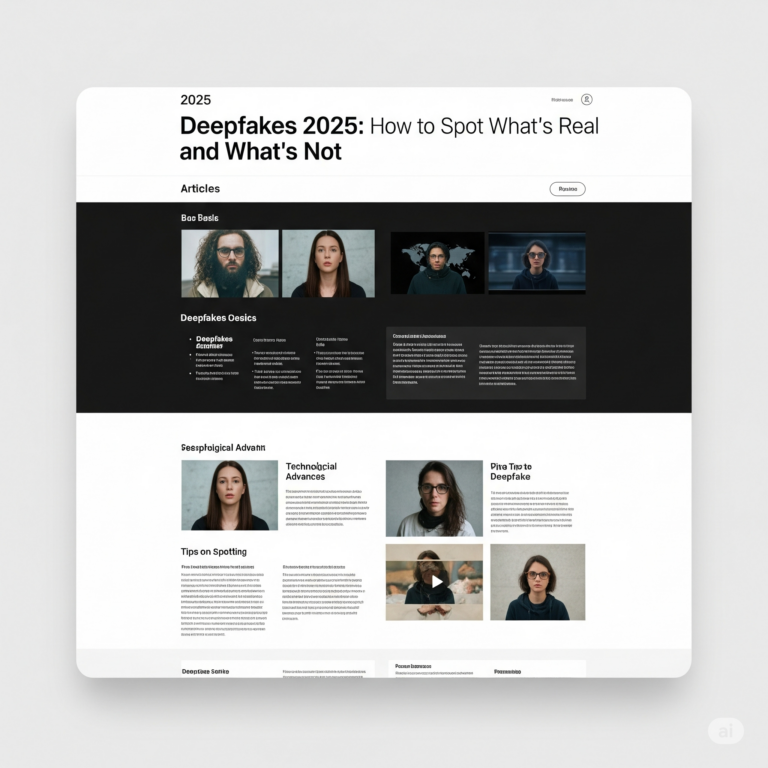- 📰 Introduction: Deepfakes 2025 Are More Convincing Than Ever
- 🤖 What Makes Deepfakes 2025 So Hard to Detect?
- ⚠️ The Risks of Undetectable Deepfakes
- 🛠️ How to Spot a Deepfake in 2025
- 🌐 Big Tech’s Response to Deepfakes 2025
- 📱 What You Can Do to Stay Safe
- ✅ Conclusion: Staying Ahead of Deepfakes in the Age of AI
📰 Introduction: Deepfakes 2025 Are More Convincing Than Ever
In deepfakes 2025, the line between reality and digital manipulation is nearly invisible. Powered by advanced AI models, fake videos, audio clips, and images now look disturbingly real — often indistinguishable to the naked eye. As misinformation spreads faster than truth, knowing how to recognize synthetic media has never been more important.
🤖 What Makes Deepfakes 2025 So Hard to Detect?
🔍 Hyperrealism Through Generative AI
Thanks to powerful tools like GANs (Generative Adversarial Networks) and video diffusion models, fake content now mimics real-world lighting, facial expressions, and speech patterns flawlessly. Some can even pass through basic AI detection filters.
🧠 Real-Time Generation
The biggest leap in deepfakes 2025 is real-time video and voice synthesis. Deepfake apps can now render manipulated content during live calls or streams, making detection even more challenging.
⚠️ The Risks of Undetectable Deepfakes
📰 Political and Social Manipulation
Fake videos of politicians, CEOs, or celebrities can sway public opinion, influence elections, or cause real-world panic — especially when spread rapidly on social media.
👥 Personal Scams and Identity Theft
Ordinary people are also being targeted. Deepfakes of your voice or face can be used for fraud, blackmail, or impersonation, with devastating effects.
🛠️ How to Spot a Deepfake in 2025
👁️ Watch the Eyes and Mouth
Even the most advanced deepfakes struggle with subtle eye movements, blinking patterns, and lip-sync accuracy. Look for unnatural expressions or timing issues.
🖼️ Use Verified Tools
New browser extensions and apps are emerging that scan media for signs of tampering. Platforms like Microsoft’s Video Authenticator or Intel’s FakeCatcher analyze pixels, shadows, and data inconsistencies.
🌐 Big Tech’s Response to Deepfakes 2025
🛡️ Content Authentication Technology
Google, Meta, and Adobe are implementing provenance tracking, which adds invisible markers to original files, helping users verify authenticity across the web.
⚖️ Governments Step In
Some countries now require mandatory labeling of AI-generated media. The EU’s AI Act, for example, mandates clear disclosure when content has been artificially created or altered.
📱 What You Can Do to Stay Safe
- Always verify media from multiple sources before sharing.
- Be skeptical of emotional or sensational content — it’s a common manipulation tactic.
- Use trusted fact-checking tools or browser plug-ins.
- Educate friends and family on the dangers of deepfakes 2025.
✅ Conclusion: Staying Ahead of Deepfakes in the Age of AI
The rise of deepfakes 2025 is a double-edged sword. While the technology can power entertainment and creativity, it also fuels deception and distrust. In this new era, media literacy is your best defense. Knowing how to question what you see — and verifying it — may be the only way to stay ahead of what’s real and what’s not.


